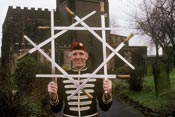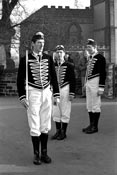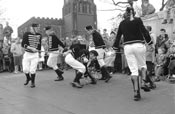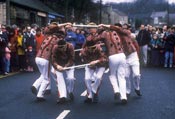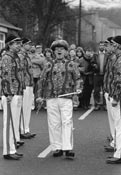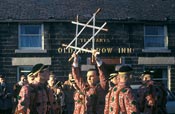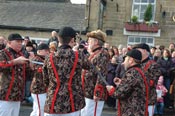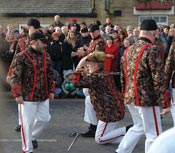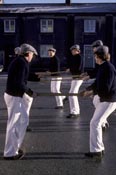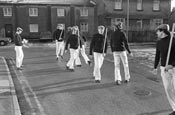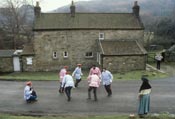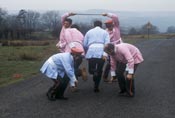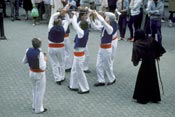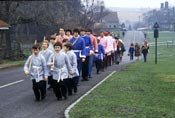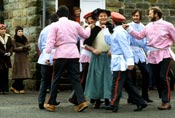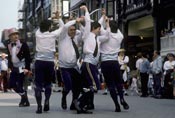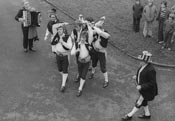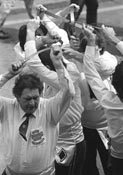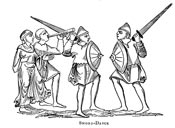
English Sword Dancing is another northern tradition, taken up enthusiastically by ‘revival’ morris dancers all over the country. It bears no resemblance to Scottish sword dancing, which is about stepping between crossed swords placed on the ground. In English sword dancing the dancers dance complicated figures over and under the ‘swords’ while holding them at both ends in a continuous chain (known as ‘hilt and point’), which usually leads to a sword ‘lock’, triumphantly displayed at the end. Obviously they are not actual swords but long steel or wooden lathes in Longsword dancing, or short flexible steel lathes with a handle at each end in Rapper Sword Dancing.
Longsword dancing originated in Yorkshire and there are several ‘traditional’ sides still dancing, each with a distinctive style. Grenoside and Handsworth, to the north and east of Sheffield respectively, have a robust, vaguely militaristic approach. Even their costumes. They both come out on Boxing Day so it is possible, traffic and sat-nav willing, to see them both. Flamborough, away over on the east coast near Bridlington, also appear on Boxing Day, dressed more like fishermen and dancing in a way more akin to the gentler ‘Cleveland Style’ found in the north of the county. Goathland Plough Stots appear in January near Plough Monday, the beginning of the agricultural year. Once the ‘stots’ (Yorkshire for ‘bullocks’) pulled a plough around the neighbourhood as part of the ritual. Goathland were unable to muster a team when Collections enquired in the 1960s but were able to field three teams in 1980 – and they are still flourishing. Loftus has also had a chequered history but have been going since the Festival of Britain in 1951. They are notable for their mysterious ‘Old Woman’ who glides among the dancers like a sinister black ghost. Really weird. It would be neat to connect Longsword Dancing with the steel industry which abounded in Sheffield and on Teesside, and a mile from Loftus at Skinningrove, but we don’t think it had much more to do with it than providing the rigid swords..
On the other hand Rapper Sword Dancing, native to Durham, Tyneside and Northumberland probably did have a lot to do with coal mining. The mines are all gone now but 150 years ago there were hundreds of pits in the North East. The work was hard and dangerous and when the miners came up for air after a shift they needed something exciting and liberating. Collections would suggest that they simply took the longsword dances and adapted them to their own needs, which were to let off steam and show those nancy-boys to the south what real sword dancing was. The flexible high grade steel of the rapper swords was not invented until the mid-nineteenth century, and was then too expensive for miners to afford so it is surmised that the swords evolved from discarded/borrowed mining equipment. We seem to remember a similar gizmo for scraping sweat off pit ponies. Whatever, the whole exercise is spectacular and performed at such breakneck speed that Collections wonders how they can do it without injuring themselves. See the pictures of High Spen Blue Diamonds. Royal Earsdon have an honoured place in the history of rapper but seem to have disappeared for now. Our picture was taken on New Year’s Day 1973
